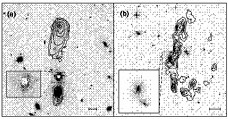


Collisions between giant disk galaxies may trigger the formation of
dwarf galaxies. This idea, which was first proposed by
[29]
and later by
[21],
has received recent observational
support [14,
15,
5,
3].
Renewed interest
in this phenomenon arose from the inspection of the optical images of
ULIGs, which frequently exhibit patches of optically emitting material
along the tidal tails (see
Figure 3a-c). These
objects appear to become bluer near the tips of the tails at the position of
massive clouds of HI. These condensations have a wide range of
absolute magnitudes, MV ~ -14 to -19.2, and
HI masses, M(H I) ~ 5 × 108 to
6 × 109
M .
[13]
have shown that objects
resembling irregular dwarfs, blue compacts, and irregulars of
Magellanic type are formed in the tails. These small galaxies of
tidal origin are likely to become detached systems, namely, isolated
dwarf galaxies. Because the matter out of which they are formed has
been removed from the outer parts of giant disk galaxies, the tidal
dwarfs we observe forming today have a metallicity of about one third
solar [2].
.
[13]
have shown that objects
resembling irregular dwarfs, blue compacts, and irregulars of
Magellanic type are formed in the tails. These small galaxies of
tidal origin are likely to become detached systems, namely, isolated
dwarf galaxies. Because the matter out of which they are formed has
been removed from the outer parts of giant disk galaxies, the tidal
dwarfs we observe forming today have a metallicity of about one third
solar [2].
It is interesting that in these recycled galaxies of tidal origin there is - as in globular clusters - no compelling evidence for dark matter [13]. To find the true fraction of dwarf galaxies that may have been formed by processes similar to the tidal interactions we observe today between giant spiral galaxies, more extensive observations of interacting systems will be needed. A recent step forward is the statistical finding that perhaps as much as one half of the dwarf population in groups is the product of interactions among the parent galaxies [7].
Tidal dwarfs are formed not only during spiral-spiral mergers, but also in encounters of spirals with massive ellipticals in clusters of galaxies. In Figure 6 are shown the results from the multiwavelength study of Arp 105 and NGC 5291A/B which are in clusters of galaxies. In Arp 105, [3] find tidal dwarfs that resemble Magellanic Irregulars and a blue compact. In NGC 5291, about 10 tidal dwarfs of irregular morphology are found associated to the 200 kpc HI ring shown in Figure 6 [4].

|
Figure 6. (a) NGC3561A/B (Arp105) from
[3];
(b) NGC5291A/B ("Sea shell") from
[4].
Tidal dwarfs may have different morphologies: Blue compacts,
Magellanic Irregulars, and Dwarf Irregulars. Contours of HI
21-cm line column density (black) are superimposed on deep
optical (r-band) images. Inserts show a more detailed view in
r-band of the spiral galaxy NGC3561A
[3], and of
the interacting pair NGC5291A/B. White contours represent the
CO(1 |